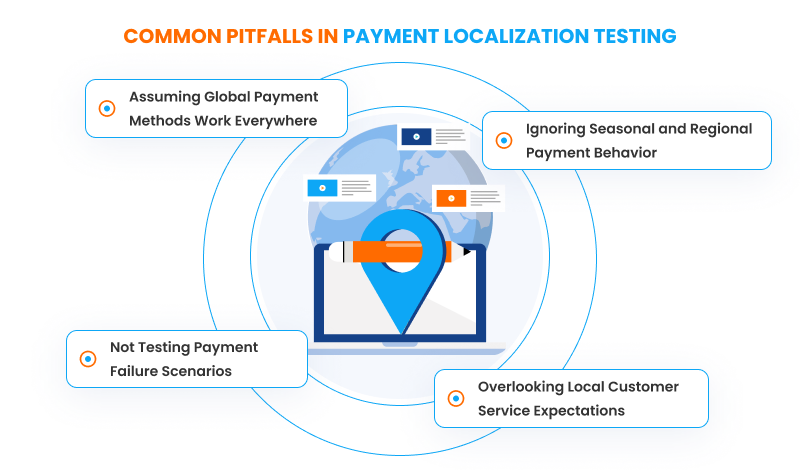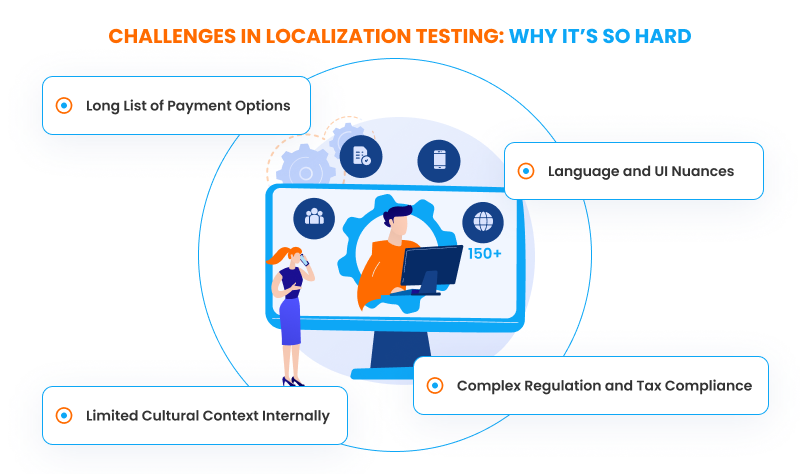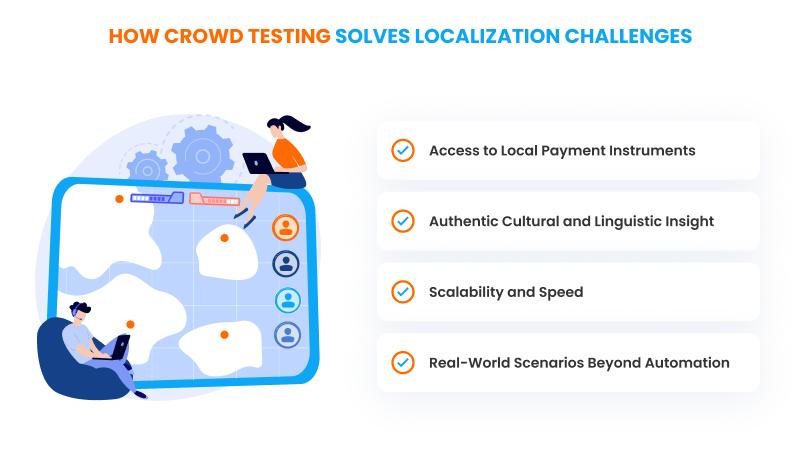Build User Trust by Getting Localization Right in Payment Testing

Did you know that nearly 70% of online shoppers abandon their carts at checkout? This happens a great deal in international markets due to payment problems. Common questions users ask include: “Why does my card get declined at checkout?” and “Can I use local wallets or payment apps?” These concerns reflect the confusion and friction caused by poor payment localization. Payment friction varies wildly by region. What works perfectly in the U.S. can be confusing or even impossible in Brazil or China. When shoppers hit a wall at the checkout, trust disappears in a hurry.
In the online world, user payment trust is all that counts. Clients won’t hesitate to leave your site if they don’t know how to pay or are afraid of hidden fees or insecurity. That’s where payment localization comes in - a high-level strategy to present your checkout system as appearing local, trusted, and secure to all users, no matter where they are in the world. But what is payment localization, and why is it so critical? It's a strategic process crucial for boosting conversion rates and user engagement. Let’s see.
What Questions Do Shoppers Ask About Payment Localization?
Many shoppers want to know: “Are my local payment methods supported?” “Will I see prices in my own currency?” and “Is my payment information secure?” Addressing these questions directly through clear payment flows and localized content can directly increase conversion rates.
What Is Payment Localization?

By payment localization, we mean adapting the transaction experience to the local users’ expectations, regulations, and usage in a region or country. It is not word translation alone. It is all that relates to payments getting into harmony with what local users expect and perceive.
What Does Payment Localization Include?
Payment localization is tailoring your purchase experience to the needs of users in a specific country or region. It involves more than just translating your checkout page, it’s about adhering to local expectations, behaviors, and compliance.
Crucial elements are:
- Language and translation for every payment-related text
- Correct exchange rates and currency formatting
- Support for local billing instruments, such as UPI, Pix, or Klarna
- Correct address, ZIP code, and telephone number formats
- Presentation of local taxes and legal information
Answering top search intent like: “How can I pay using my local bank?” and “Will my payment fail if formats aren’t correct?” requires testing every aspect for user comfort and reliability.
These adaptations make customers feel the platform was created for them, generating trust and reducing friction at checkout. It also aids in compliance with local financial laws, avoiding costly errors.
In short, payment localization is not just a UX improvement. It’s a critical technique for generating trust, reducing cart abandonment, and succeeding in global payment testing.
Why Does Localization Build User Trust?
People trust what they are familiar with. When shoppers see their local currency, their usual banks, or payment methods they already use, they instantly feel safe. This familiarity dispels doubts about security and fraud.
How Localization Builds Trust
- Speaking their language: Shoppers feel at ease when all the information on the checkout page is set to their culture and language.
- Using familiar payment methods: Offering options like PayPal, local credit cards, or local wallets shows that you understand their requirements.
- Transparent tax and price details: Localized and transparent pricing does away with confusion and suspicion.
- Reduced cart abandonment: When payment options and flows match expectations, fewer customers jump ship.
- Higher satisfaction: Smooth, localized experiences lead to more satisfied users.
Fast payment processing and clear error messages are two “make or break” factors highlighted by users when choosing whether to complete checkout or not.
In short, enhancing the trust of users in fintech apps depends heavily on payment localization.
Common Pitfalls in Payment Localization Testing

Even businesses keen on localization get it wrong. The following are some typical traps.
1. Assuming Global Payment Methods Work Everywhere
Just because an option like Visa or PayPal is popular doesn’t mean it’s both available and trusted everywhere. Failing to test local payment options will kill conversions.
2. Overlooking Local Customer Service Expectations
Users expect different kinds of support depending on where they are. A 24/7 hotline, speaking the local language, can be vital in one place and overkill in another.
3. Not Testing Payment Failure Scenarios
Testing will focus on success paths only. But what happens when a payment fails? Localized error messages and recovery methods must be carefully tested.
4. Ignoring Seasonal and Regional Payment Behavior
Payment conduct differs during holiday seasons or sale periods, and there are particular charge cycles in some areas. Failing to account for this leads to surprises.
Key Areas to Localize in Payment Testing
Effective international payment testing is a matter of paying attention to some key areas.
Currency, Pricing, and Formats
- Display prices in the right currency.
- Use accurate conversion rates.
- Display proper currency formatting testing for decimals, commas, and symbols.
Language and Translations
- Do language testing in payments for every UI component.
- Make sure error messages and payment prompts are clear and culturally relevant.
Payment Methods
- Install region-specific features like Alipay, Klarna, UPI, Pix, PayBox, or PayPal.
- Test availability and smooth transaction flow on all channels.
Address and Contact Information Formats
- Modify address fields to follow local conventions.
- Verify for phone numbers and ZIP codes that accept regional differences.
Time Zones and Dates
- Show dates and times in the local manner.
- Make daylight saving adjustments if necessary.
Local Taxes, Invoices, and Legal Obligations
- Add regional VAT or GST.
- Create invoices to local specifications.
- Test for compliance with payment regulations.
Error Handling and Edge Cases
- Localize error messages.
- Fail the simulation and network test.
- Test edge conditions like refunds or currency conversions.
Challenges in Localization Testing: Why It’s So Hard

Localization testing is complex and hard to get right. Following are some of the key challenges.
Long List of Payment Options
It’s not just credit cards anymore. You have to test local options such as iDEAL in the Netherlands, Pix in Brazil, WeChat Pay in China, PayBox in Israel, BNPL options in Europe, and many more. This variety is a challenge to deal with.
Complex Regulation and Tax Compliance
Different countries have different taxes and regulations. You need proper payment testing for global markets to meet VAT, GST, and transaction charges.
Language and UI Nuances
Error messages, button labels, and instructions must be read naturally and correctly in each language. Poor translation kills trust.
Limited Cultural Context Internally
Internal personnel typically lack the true cultural insight or local payment systems access, so there are testing gaps.
How Crowd Testing Solves Localization Challenges

This is where crowd testing for localization comes into its own. Instead of entrusting it to in-house teams or automated script tests in isolation, crowd testing introduces you to real users from the very countries you wish to sell to. They test payment journeys on their own devices, in actual local environments, and with actual local payments. This approach provides you with insights no traditional QA process can match.
Access to Local Payment Instruments
Crowd testers are exposed to actual local payment instruments. Think Alipay in China or UPI in India, which may not be available to them or be hard to simulate within ordinary QA environments. This ensures that your charging system works flawlessly with the payment methods customers want to use.
Authentic Cultural and Linguistic Insight
Local testers are aware of those delicate cultural and language nuances that internal testers tend to overlook. They pick up on errors in translations, clunky wording, or even misleading UI components, making your multilingual payment testing actually accurate and friendly to users.
Scalability and Speed
You can now run tests across a multitude of countries and regions simultaneously with crowd testing. No need to set up expensive local offices or elaborate infrastructure to replicate many environments - the crowd testers are already there, eager to give you fast, consistent responses.
Real-World Scenarios Beyond Automation
While repeated checks can be handled efficiently by automated tests, they always miss nuanced real-world scenarios like fluctuating currency exchange rates, non-standard error messages, or inconsistent user behavior during checkout. Live users bring in randomness and variability, uncovering edge cases that automated tests overlook.
Putting It All Together: Why Localization in Payment Testing Is Your Growth Secret
Businesses that are truly committed to international expansion cannot afford to treat taking transactions as a “one size fits all” issue. Payment localization is the key to fostering user trust in fintech and preventing costly cart abandonment. Businesses that aim to compete globally must implement cross-border payment testing covering all the bases, from regional gateway validation by geography to mobile payment localization and localized checkout flow testing.
By using crowd testing for localization, you gain unmatched accuracy, cultural context, and coverage. Our method allows you to create checkout experiences that consumers all over the world are familiar with and trust, ensuring a smooth journey from cart to checkout. This approach boosts your conversion rates, turning occasional shoppers into repeat buyers.
Don’t let payment friction hold you back. reach out to our experts and boost user trust through successful payment localization today.

